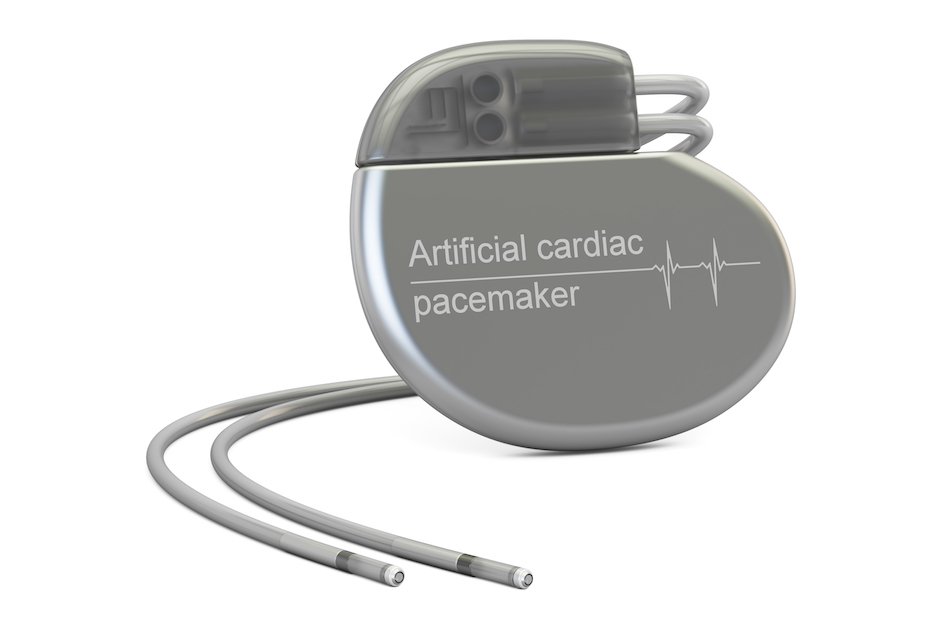A pacemaker is a small box, containing electronic circuits powered by a battery. It is connected to the heart by one, two or three probes depending on the case. It is able to constantly analyze the rhythm of the heart, especially when it is abnormal, and to stimulate it if necessary without the slightest unpleasant sensation. In addition, this pacemaker can store information about the heart rate and data about how it works.
In summary, the pacemaker only works if the heart rate falls below a reference threshold determined by the doctor. The function of the pacemaker is to cause cardiac contractions that the heart can no longer perform properly on its own by sending it electrical stimuli.
The case is a small round device a few centimetres in diameter (maximum 10 cc) filled with electronics and implanted under the skin, at the level of the clavicle. It weighs between 20 and 50g. It contains a lithium battery and is connected to the heart by probes.
Pacemaker probes are flexible electrodes that connect the case to the cavities of the heart. They go through the veins. The case can be connected to a single probe with two probes or three probes in case of heart failure.
In the case of a single probe pacemaker, it stimulates the right ventricle. When there are two probes, they stimulate the atrium and right ventricle. In the case of a three-probe pacemaker, the third probe is implanted by the coronary sinus, in contact with the left ventricle.
The pacemaker can also have a defibrillation function delivering electric shocks if necessary, in the case of severe rapid rhythm disorders, especially in cases of heart failure.
Duration of hospital stay
24 to 48 hours.
Heart rate monitoring is required.
Average length of stay
3 to 7 days.
It is important to rest after the operation.

Every year, nearly 11 million patients go abroad in search of medical care. At MEDICAIM, we provide our patients with access to the best hospitals and doctors around the world. Contact us to learn more about your treatment options.
Ask for your free quote abroad
Start your medical stay by requesting a quote. Our customer service department will help you find the clinic that best suits your needs and get you a quote.
The patient is fasting and has had a blood test to check the coagulation and fluidity of the blood.
In most cases, antibiotics are given before the procedure to prevent a possible infectious problem. The cardiologist will answer all your questions.
The installation of a pacemaker requires a surgical procedure that lasts between 1 and 2 hours. This is done under local anesthesia. However, you must be hospitalized to ensure that everything is working properly after installation
During the operation an incision (5 to 6cm) is made under one of the two clavicles. This is where the probes are introduced into a vein. The probes are pushed into the venous network, the cardiologist introduces and pushes the probes into the heart, controlling his gesture by radioscopy. Their ends are then placed in the appropriate heart cavities. The probes are then connected to the case, directly implanted under the skin, in the subclavicular region or under the pectoral muscle.

The length of hospitalization is short, you can leave the hospital 24 to 48 hours after the operation.
The threads of the scar are removed around the eighth day.
When it is only a question of changing the case, the operation is faster, the probes remaining in place.
Regular follow-ups are to be planned in order to verify the proper functioning of the system. A first check is carried out within 3 months after installation and then regularly every 6 months to 1 year in general.
The medical team will monitor the patient's heart rate and a chest X-ray will be taken to ensure that the lungs are functioning properly and the pacemaker is placed.
After the procedure, patients will receive a pacemaker ID card indicating the brand and model they have been fitted with. They will always have to keep it with them.
The cases have a limited lifetime. They should be changed about every ten years.
Potential risks:
• Pacemaker malfunction
• Infection
Some complex diseases such as cancer can lead some patients to seek a second medical opinion. Almost 50% of patients using the second medical opinion have seen their treatment options evolve. Seeking a second medical opinion is perfectly legitimate when faced with a serious illness.
Click here to find out more about the second MEDICAIM medical opinion
MEDICAIM takes care of the follow-up on a case-by-case basis. www.medicaim.com
MEDICAIM is looking for the best specialists for you and we will offer you several renowned doctors.
MEDICAIM organizes your entire stay for you: post-operative nursing care, biological follow-up, therapeutic, nutritional and psychological support.
Any additional questions? Ask your MEDICAIM doctor about it: careteam@medicaim.com
Some needs and conditions are more complex than others. In case of doubt, please send us additional information to establish a customized quote.
Ask for a quoteCertains besoins et pathologies sont plus complexes que d’autres. En cas de doute, faîtes-nous parvenir des informations complémentaires pour établir un devis sur-mesure.
Demander un devisEntrust us with your medical file and it will be examined by a specialist doctor. The goal?
Allow you to evaluate all your treatment options.